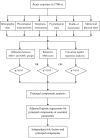Principal Component Analysis and Risk Factors for Acute Mountain Sickness upon Acute Exposure at 3700 m
- PMID: 26554385
- PMCID: PMC4640520
- DOI: 10.1371/journal.pone.0142375
Principal Component Analysis and Risk Factors for Acute Mountain Sickness upon Acute Exposure at 3700 m
Abstract
Objective: We aimed to describe the heterogeneity in the clinical presentation of acute mountain sickness (AMS) and to identify its primary risk factors.
Methods: The participants (n = 163) received case report form questionnaires, and their heart rate (HR), oxygen saturation (SpO2), echocardiographic and transcranial Doppler variables, ability to perform mental and physical work, mood and psychological factors were assessed within 18 to 22 hours after arriving at 3700 m from sea level (500 m) by plane. First, we examined the differences in all variables between the AMS-positive and the AMS-negative groups. Second, an adjusted regression analysis was performed after correlation and principal component analyses.
Results: The AMS patients had a higher diastolic vertebral artery velocity (Vd; p = 0.018), a higher HR (p = 0.006) and a lower SpO2. The AMS subjects also experienced poorer sleep quality, as quantified using the Athens Insomnia Scale (AIS). Moreover, the AMS population exhibited more negative mood states, including anxiety, depression, hostility, fatigue and confusion. Five principal components focused on diverse aspects were also found to be significant. Additionally, more advanced age (p = 0.007), a higher HR (p = 0.034), a higher Vd (p = 0.014), a higher AIS score (p = 0.030), a decreased pursuit aiming capacity (p = 0.035) and decreased vigor (p = 0.015) were risk factors for AMS.
Conclusions: Mood states play critical roles in the development of AMS. Furthermore, an elevated HR and Vd, advanced age, elevated AIS sores, insufficient vigor and decreased mental work capacity are independent risk factors for AMS.
Conflict of interest statement
Figures



Similar articles
-
Age as a risk factor for acute mountain sickness upon rapid ascent to 3,700 m among young adult Chinese men.Clin Interv Aging. 2014 Aug 6;9:1287-94. doi: 10.2147/CIA.S67052. eCollection 2014. Clin Interv Aging. 2014. PMID: 25120358 Free PMC article.
-
A higher baseline somatization score at sea level as an independent predictor of acute mountain sickness.Physiol Behav. 2016 Dec 1;167:202-208. doi: 10.1016/j.physbeh.2016.09.008. Epub 2016 Sep 14. Physiol Behav. 2016. PMID: 27640135
-
Physiological and psychological factors associated with onset of high-altitude headache in Chinese men upon acute high-altitude exposure at 3700 m.Cephalalgia. 2017 Apr;37(4):336-347. doi: 10.1177/0333102416646761. Epub 2016 May 5. Cephalalgia. 2017. PMID: 27152016
-
Non-high altitude methods for rapid screening of susceptibility to acute mountain sickness.BMC Public Health. 2013 Sep 30;13:902. doi: 10.1186/1471-2458-13-902. BMC Public Health. 2013. PMID: 24079477 Free PMC article. Review.
-
The Use of Pulse Oximetry in the Assessment of Acclimatization to High Altitude.Sensors (Basel). 2021 Feb 10;21(4):1263. doi: 10.3390/s21041263. Sensors (Basel). 2021. PMID: 33578839 Free PMC article. Review.
Cited by
-
Anxiety as a Risk Factor for Acute Mountain Sickness Among Young Chinese Men After Exposure at 3800 M: A cross‒sectional Study.Neuropsychiatr Dis Treat. 2023 Nov 28;19:2573-2583. doi: 10.2147/NDT.S436438. eCollection 2023. Neuropsychiatr Dis Treat. 2023. PMID: 38046832 Free PMC article.
-
Association between acute mountain sickness (AMS) and age: a meta-analysis.Mil Med Res. 2018 May 11;5(1):14. doi: 10.1186/s40779-018-0161-x. Mil Med Res. 2018. PMID: 29747689 Free PMC article. Review.
-
Hiccups and Slurring of Speech: Atypical Presentation of High-Altitude Cerebral Edema.Cureus. 2023 Feb 14;15(2):e34997. doi: 10.7759/cureus.34997. eCollection 2023 Feb. Cureus. 2023. PMID: 36938238 Free PMC article.
-
Low Stroke Volume Index in Healthy Young Men Is Associated with the Incidence of Acute Mountain Sickness after an Ascent by Airplane: A Case-Control Study.Biomed Res Int. 2020 Nov 10;2020:6028747. doi: 10.1155/2020/6028747. eCollection 2020. Biomed Res Int. 2020. PMID: 33224980 Free PMC article.
-
Acute mountain sickness predicts the emotional state of amateur mountaineers.Sci Rep. 2024 Feb 27;14(1):4799. doi: 10.1038/s41598-024-55291-3. Sci Rep. 2024. PMID: 38413690 Free PMC article.
References
Publication types
MeSH terms
LinkOut - more resources
Full Text Sources
Other Literature Sources

